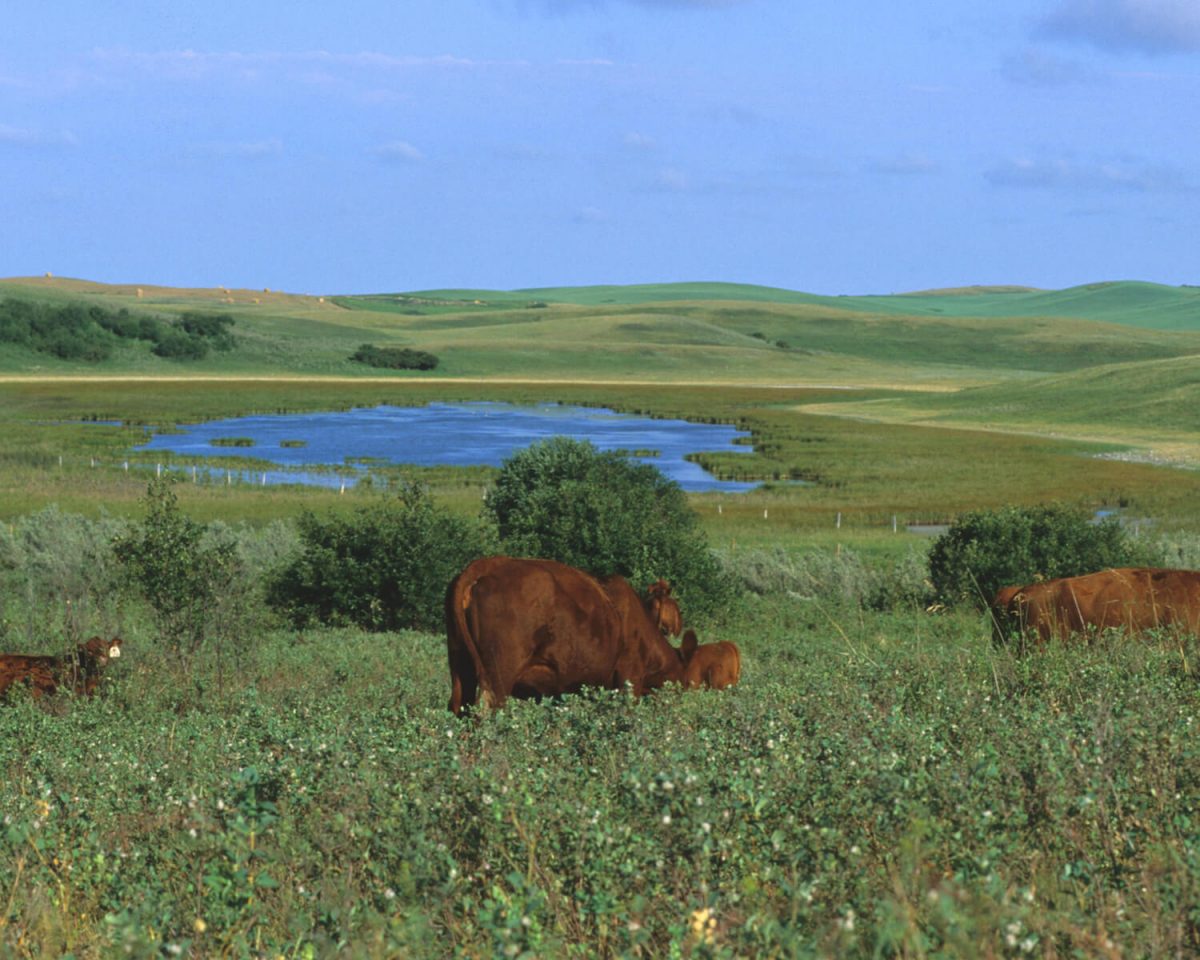
Cattle Country: Beef production supports the preservation of prairie wetlands
The following article was written by Peter Frohlich, National Centre for Livestock and the Environment (NCLE), University of Manitoba. It was originally published in Cattle Country in August 2022.
Typical descriptions of wetlands portray these ecosystems as abundant sources of fresh water, rich vegetation, habitats for migrating waterfowl and other wildlife. Throughout Canada, these ecosystems can be found on the prairies, in the boreal forest, along coastlines and even in the tundra. According to Ducks Unlimited Canada (DUC) our wetlands are truly diverse. They can appear as marshes, bogs, fens, swamps and open water. However, there is much more to these ecosystems then meets the eye. From the environmental and the sustainability perspectives, Canada’s wetlands play an important role in carbon cycling and climate regulation, water quantity and quality regulation, and are hotspots for biodiversity. Essentially prairie wetlands provide an abundance of ecosystem services, benefits humans derive from various natural environments. Furthermore, Canada’s wetlands are an important part of the cattle ranching landscape. These ecosystems can serve as a valuable source of water and forage and can provide refuge to cattle on hot days.
Agriculture, Urban Expansion and Conservation
During past decades, drainage due to agricultural and urban expansion and the historical extraction of resources have not been kind to these diverse ecosystems. According to DUC, the existence of wetlands has slowly declined and in settled areas of Canada, up to 70% of our wetlands have already been destroyed or degraded.
For over 80 years, conservation groups like DUC have been effectively moving wetland preservation activities forward. DUC has been achieving results that have significantly helped to protect these disappearing ecosystems. However, there is still a lot of work that needs to be done to slow and stop the disappearance of prairie wetlands.
In the spring of 2020 DUC partnered with researchers from the National Centre for Livestock and the Environment at the University of Manitoba, and Agriculture and Agri-Food Canada to create a multidisciplinary team whose goal is to investigate ecosystem services derived from wetlands and to further explore the benefits of wetlands embedded in grasslands that serve as cattle grazing environments. With funding from the Beef Cattle Research Council, the governments of Canada and Manitoba through the Ag Action Manitoba program, and the Alberta North American Waterfowl Management Plan Partnership this project will quantify ecosystem-level carbon sequestration and investigate greenhouse gas emissions (GHG) and microclimate regulation while exploring nutrient retention, water storage and biodiversity on prairie wetlands.
Scope of the Prairie Ecosystems Services Project
Data collection is centered on wetlands located within grasslands, as well as croplands. The ecosystems under investigation are associated with three watersheds located throughout the prairies including two grassland and two annual cropland sites in the Prairie Pothole Region of southwestern Manitoba. The data will also be collected in conjunction with information collected from sites from an extensive survey of GHG emissions from wetlands embedded in grasslands and cropland from three prairie watersheds across Alberta, Saskatchewan and Manitoba.
In addition to assessing numerous ecosystem services, the research explores the impact of converting grassland to annual crop land and the resulting effects on biodiversity using waterfowl as a model. The study is also measuring the proportion of prairie wetland habitats that exist within beef production landscapes and provides an estimate of ecosystem services associated with these habitats using the DUC waterfowl productivity model.
Using unique strategies to measure greenhouse gas emissions
The study employs the use of Eddy Covariance Systems or flux towers to capture GHG exchange at the wetland scale. Traditionally, flux towers are used to study GHG emissions associated with ecosystems such as forests, peatlands and coastal salt marshes but have rarely been used to study small freshwater wetland ecosystems that are present in the Canadian prairie region. The main benefit of this technique is that GHG measurements capture a larger footprint incorporating the various ecotones of a wetland (open-water, emergent vegetation, wet meadow etc.) allowing for better quantification of GHG exchange and carbon sequestration across the entire wetland.
What have we learned so far?
According to Pascal Badiou, a research scientist with DUC and project lead, data collected thus far shows that the type of vegetation and the amount of open water has a significant impact on the GHG emissions associated with a wetland. Sulphate and phosphorous affect methane production. Increased sulphate and decreased phosphorous levels in an environment promote lower methane emissions. Results from the study show that wetlands embedded in in cropland have higher phosphorous and lower sulphate concentrations, resulting in higher methane emissions. Conversely wetlands that include perennial cover such as grasslands have higher sulphate but lower phosphorous concentrations resulting in overall lower methane emissions.
Furthermore, Badiou says that it may be beneficial for farmers to maintain perennial cover around wetlands imbedded within crop land as this vegetations is a buffer between crops, improving water quality by removing phosphorous and reducing GHG emissions.
As the project continues, researchers will continue to quantify differences in water quality and water quantity of wetlands embedded in grassland relative to cropland. The research will also examine biodiversity impacts of converting grassland to annual cropland and quantify wetland habitat that exists within beef production landscapes based on ecosystem services provided. The project is scheduled to conclude in the spring of 2024.
Findings from the project will improve the understanding of the ecosystem services associated with prairie wetlands embedded in prairie beef production landscapes. Using natural climate solutions such as the preservation of grasslands and wetlands by beef producers represents a major environmental service associated with the beef industry. Accounting for these ecosystem services is key to developing effective communications to increase public knowledge, assist in policy implementation and to enhance the public confidence in the beef industry.
For more information on the study please contact Ducks Unlimited Canada at media@ducks.ca






